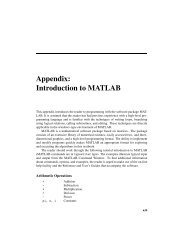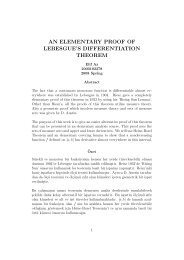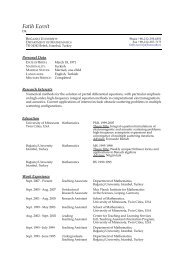A short document on the literature review and project content
A short document on the literature review and project content
A short document on the literature review and project content
You also want an ePaper? Increase the reach of your titles
YUMPU automatically turns print PDFs into web optimized ePapers that Google loves.
Esc 577, Systems Modelling for Envir<strong>on</strong>mental Dynamics, Fall 2012<br />
I. LITERATURE REVIEW PAPERS<br />
The <strong>the</strong>me selected for <strong>literature</strong> <strong>review</strong> must be <strong>on</strong> systems thinking, systems <strong>the</strong>ory, system<br />
dynamics, dynamic systems modelling, dynamic modelling <strong>and</strong>/or computer simulati<strong>on</strong> applied<br />
to a specific field of knowledge.<br />
Literature <strong>review</strong> papers must be oriented toward a specific research questi<strong>on</strong> <strong>and</strong> purpose in<br />
your mind. It must provide a critical look to <strong>the</strong> previous research in your field, related to your<br />
purpose <strong>and</strong> in relati<strong>on</strong> to <strong>the</strong> methods that you are going to use. Ultimate purpose of a<br />
<strong>literature</strong> <strong>review</strong> is to crystallize <strong>the</strong> research problem, hypo<strong>the</strong>sis <strong>and</strong> research design. While<br />
reading <strong>the</strong> <strong>literature</strong> <strong>and</strong> writing <strong>the</strong> <strong>literature</strong> <strong>review</strong> papers, you must always stay relevant<br />
with this purpose. You must provide informati<strong>on</strong> ei<strong>the</strong>r a related few or all of <strong>the</strong> following:<br />
Previous knowledge in <strong>the</strong> field; existing <strong>the</strong>ories <strong>and</strong> explanati<strong>on</strong>s; inc<strong>on</strong>sistencies of <strong>the</strong>se<br />
explanati<strong>on</strong>s; lacking evidence; fur<strong>the</strong>r research problems; <strong>and</strong> fur<strong>the</strong>r research designs.<br />
Literature <strong>review</strong> papers must have a title related to <strong>the</strong> intended research. First, purpose of <strong>the</strong><br />
<strong>literature</strong> <strong>review</strong> must be menti<strong>on</strong>ed in a <str<strong>on</strong>g>short</str<strong>on</strong>g> abstract (around 200 words). Then <strong>the</strong> <strong>literature</strong><br />
must be <strong>review</strong>ed in an assay, trying to answer <strong>the</strong> above questi<strong>on</strong>s. This paper may c<strong>on</strong>sist of<br />
about 7 pages. A minimized versi<strong>on</strong> of this paper may serve as <strong>the</strong> <strong>literature</strong> <strong>review</strong> chapter of<br />
<strong>the</strong> term paper.<br />
II. TERM PROJECTS AND PAPERS<br />
Projects will be about a formal ma<strong>the</strong>matical model originally developed by <strong>the</strong> students, or<br />
about a formal model in <strong>literature</strong> that is c<strong>on</strong>siderably modified <strong>and</strong> improved by <strong>the</strong> students<br />
<strong>the</strong>mselves.<br />
There can be alternative purposes: You can choose to analyse a biological or physical process as<br />
it develops in <strong>the</strong> envir<strong>on</strong>ment or in laboratory c<strong>on</strong>diti<strong>on</strong>s. The ultimate aim should be to<br />
describe <strong>and</strong> clarify <strong>the</strong> <strong>the</strong>ory about <strong>the</strong> causes of observed problematic behaviors. Ano<strong>the</strong>r<br />
1
purpose can be to analyse an envir<strong>on</strong>mental policy problem at corporate or public scale. In that<br />
case, <strong>the</strong> aim should be to describe <strong>the</strong> endogenous (feedback rich) causes of this<br />
envir<strong>on</strong>mental problem <strong>and</strong> to discover leverage points (leverage policies) to improve <strong>the</strong><br />
functi<strong>on</strong>ing of <strong>the</strong> system.<br />
The <strong>project</strong>s will be submitted as a research paper fulfilling academic criteria (like a paper to be<br />
presented in an academic c<strong>on</strong>ference or to be submitted to a journal – around 20 pages, not<br />
more!).<br />
Below is a brief outline that should be useful in creating write-ups.<br />
Abstract<br />
By skimming <strong>the</strong> abstract, reader should be able to underst<strong>and</strong> <strong>the</strong> research c<strong>on</strong>text; problem<br />
<strong>and</strong> purpose; method; outcomes <strong>and</strong> benefits. Length of <strong>the</strong> abstract must be around 200<br />
words.<br />
Introducti<strong>on</strong><br />
Introducti<strong>on</strong> must establish <strong>the</strong> c<strong>on</strong>text of research. What is <strong>the</strong> issue in general terms, in a<br />
broader c<strong>on</strong>text? Why it is important? A <strong>literature</strong> <strong>review</strong> secti<strong>on</strong> under introducti<strong>on</strong> can help to<br />
set <strong>the</strong> stage for an interesting research.<br />
Problem<br />
What is <strong>the</strong> problem in more specific terms? Following <strong>the</strong> dynamic simulati<strong>on</strong> methodology<br />
guidelines, describe <strong>the</strong> problem in terms of behaviour of critical variables <strong>and</strong> relevant time<br />
horiz<strong>on</strong>s required to observe <strong>and</strong> analyse those behaviours.<br />
Model descripti<strong>on</strong><br />
Model descripti<strong>on</strong> can start with introducing <strong>the</strong> c<strong>on</strong>ceptual model with causal loop diagrams.<br />
Relevant factors <strong>and</strong> variables, exogenous as well as <strong>the</strong> endogenous factors must be illustrated.<br />
2
The causal loop diagrams should depict <strong>the</strong> fundamental feedbacks operating in <strong>the</strong> formal<br />
model structure.<br />
After introducing <strong>the</strong> c<strong>on</strong>ceptual model, formal simulati<strong>on</strong> model should be introduced. The<br />
best way to describe a model is to adopt a hierarchical, top down approach. First, give an<br />
overview of its sectors <strong>and</strong> <strong>the</strong>ir interacti<strong>on</strong>s. Then describe each sector, focusing fundamentally<br />
<strong>on</strong> stock variables <strong>and</strong> formulati<strong>on</strong> of <strong>the</strong>ir flows. You must describe <strong>the</strong> important variables <strong>and</strong><br />
critical formulati<strong>on</strong>s in detail.<br />
Model validati<strong>on</strong><br />
Model must be validated with appropriate structure tests. Behaviour validati<strong>on</strong> is desirable.<br />
Model behaviour analysis<br />
Model reference behaviour (reference outputs) must be illustrated.<br />
Then model behaviour sensitivity to alternative hypo<strong>the</strong>sis must be analysed. This stage<br />
includes both parameter <strong>and</strong> structure (policy) sensitivity tests.<br />
C<strong>on</strong>clusi<strong>on</strong><br />
Describe <strong>the</strong> outcomes <strong>and</strong> <strong>the</strong>ir possible impacts in <strong>the</strong>ory <strong>and</strong> practice.<br />
References<br />
Where necessary <strong>and</strong> where available, do not forget to cite references as you write <strong>the</strong> text.<br />
Note that all references in <strong>the</strong> references secti<strong>on</strong> must be cited within <strong>the</strong> text. Use <strong>on</strong>e<br />
st<strong>and</strong>ard academic format as you cite <strong>and</strong> list your references.<br />
Last note: Use “good” English. D<strong>on</strong>’t forget to make “language check” <strong>on</strong> your word editor.<br />
Avoid unnecessarily l<strong>on</strong>g sentences <strong>and</strong> sophisticated expressi<strong>on</strong>s – that increase your<br />
probability to create “wr<strong>on</strong>g” sentences.<br />
3











